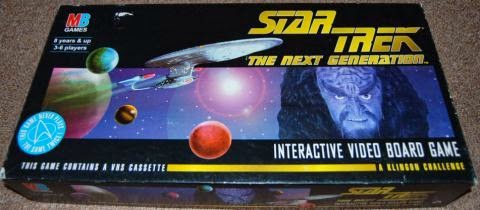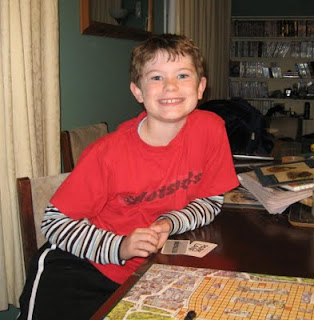http://boardgamegeek.com/boardgame/5258/star-trek-the-next-generation-interactive-vcr-boa
 |
| Big Box Outer |
TradeMe can be an interesting source of older games and having recently been working my through the seven seasons of Star Trek The Next Generation, this wee gem of a game attracted my attention. Having secured the wining bid and with the help of a friend to pick the game up from town, I was looking forward to dusting off the VCR for an hour or two of retro boardgaming with a few like minded fellows (and fellowettes).
Based on Star Trek - The Next Generation which ran from 1987 through 1994, this boardgame includes a VHS tape which runs whilst the game is in progress, assuming of course that you have a working VCR. If you don't you'll need to play this video from YouTube, but not until the game begins!
Anyhow, once you're set to start the video or YouTube clip you can setup the board and pieces ready to play. The game accommodates 3-6 players, our game had five. The first thing to do is to blindly select a rank token that determines your 'rank' on the ship and who effectively moves first. Then you select either a male or female figure and a colour. You then of course need to equip yourself with a communicator which is a sticker that you attach to your clothing and which needs to be 'tapped' when you communicate during the game! You then start the game with a Tricorder that has five spaces on it to attach Isolinear chips to which you acquire during the course of the game. You're now ready to go!
 |
| Game Board Setup |
 |
| Crew ready to go! |
The premise of the game is that the Enterprise is docked at Starbase 74 undergoing repairs for unexplained low-level computer malfunctions. You are part of a Federation repair crew on board the shp. Before the completion of work the ship is hijacked by a renegade Klingon named Kavok who's plan is to start an intergalactic war by dying in battle. You have to stop him.
The game itself is a race against the clock. You have approximately 1 hour (the length of the video) to achieve the following.
- Collect five Isolinear chips on you Tricorder
- Get a Phaser from Security
- Crawl down a Jefferies tube and attempt to gain control of the U.S.S. Enterprise to win the game.
Gameplay
 |
| Tricorder & Isolinear Chips |
On your turn you roll the die and move around the board as quickly as you can. You will start to collect computer access cards as the game progresses and these will allow you access to rooms that will mean that you start to collect Isolinear chips. As you gain these you will be able to access other parts of the ship and further cards that allow you to collect more chips.
 |
| Computer Access Cards |
Whilst this is happening the video will be playing with Kavok appearing from time to time and either helping or hindering your progress. A lot of the computer access cards have time stamps on them that allow you to do certain things at exactly the time that the card says. These can give you an advantage over your opponents or Kavok. Kavok must be answered when he appears or you will be punished, normally via a 'blj' card. These cards are often handed out by Kavok during the game.
 |
| Medal of Valour |
 |
| Trapped in status tube |
The game ends when someone has all five chips and finds themselves with a Phaser at the bridge. The turn of a card determines if they win the game, defeat Kavok and receive the 'congratulations' (yeah, right) of their fellow crew mates and receive the Medal of Valour sticker! If no-one achieves this within the time of the tape then everyone looses and........well you'll need to play the game to find out!
Our game was fairly frantic and moved quickly. The theme was well received and despite the fact that there was a fair bit of confusion about what was going on, particularly with other players, the ultimate winner was of course the Star Trek fanatic!
Good points
- Theme fitted game well
- Everyone got to be a Trekkie
- Plays 3-6
- Good length for game
- Cool stickers
Not so good points
- Roll and move mechanic
- Not a great deal of player interaction
- Despite everyone was working against Kavok there was only 1 winner.
Votes
Commander John 7/10
Engineer Andrew 7/10
Lieutenant Lisa 8/10
Engineer Andrew 7/10
Lieutenant Lisa 8/10
Cadet Peter 4/10
Chief Neil 8.5/10
(High on nostalgic value but a fairly entertaining role and move boardgame with some nice flavour, even though the mechanics themselves don't the theme very well. Recommended.)
(High on nostalgic value but a fairly entertaining role and move boardgame with some nice flavour, even though the mechanics themselves don't the theme very well. Recommended.)
Overall average 6.9
Summary
Good light fun game suitable for both adults and kids. The game is all about the theme and was enjoyable to play. Not sure there is a great deal of re-playability in this game but that's not really much of a problem. Overall a great TradeMe buy and a fun hour and a half with some gaming friends. Rules can be found here.
 |
| Chief Neil wins! |














































